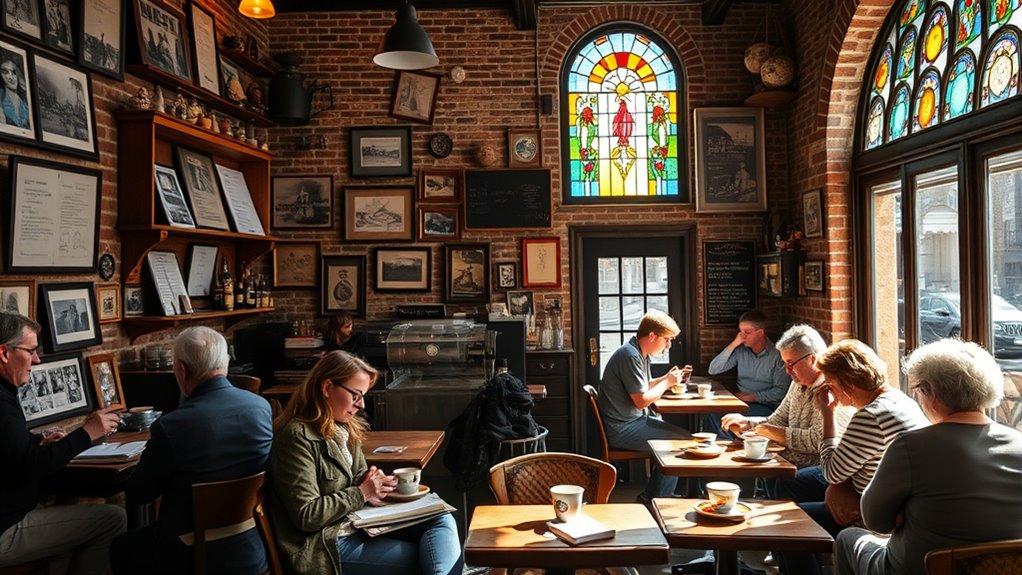Cafés serve as vibrant cultural archives, preserving history, traditions, and local identity through their architecture, decor, and ambiance. When you visit, you’re immersed in spaces that reflect generations of coffee customs and social customs, often hosting influential figures and showcasing vintage artifacts. They connect communities across time, keeping traditions alive and fostering a sense of belonging. If you explore further, you’ll uncover ways these spaces continue to preserve and celebrate cultural heritage.
Key Takeaways
- Cafés preserve historical décor, artifacts, and ambiance that reflect and celebrate local cultural traditions.
- They serve as living museums, hosting influential figures and maintaining cultural memory across generations.
- Architectural elements and interior design evoke specific eras, connecting visitors tangibly to the past.
- Cafés function as community hubs, fostering cross-generational dialogue and reinforcing shared cultural identities.
- Celebrating cafés as cultural archives highlights their role in maintaining and transmitting cultural continuity and heritage.

Have you ever considered that cafés are more than just places to grab a coffee? They serve as living repositories of culture, history, and community. When you step into a café, you’re entering a space that has often been shaped by generations of coffee traditions, each adding a layer of meaning and identity. These traditions aren’t just about brewing techniques or recipes—they’re about how coffee connects people, sparks conversations, and fosters a sense of belonging. Many cafés boast a historic ambiance, with architecture, décor, and interior design that echo the past. Walking into such a place, you might feel transported to a different era, where the clatter of cups and quiet hum of conversation tell stories that have endured over decades or even centuries.
Cafés are living museums of culture, history, and community, where every cup tells a story across generations.
The historic ambiance of a café isn’t just window dressing; it’s an essential part of its role as a cultural archive. The furniture, artwork, or even the faded wallpaper often speak to a specific time or social movement. These elements preserve the aesthetic sensibilities and social customs of bygone eras, giving you a tangible connection to history. In many cases, cafés have hosted influential figures—writers, artists, philosophers—whose work and ideas have been shaped in these very spaces. By visiting such a café, you’re not just enjoying a beverage; you’re immersing yourself in a living museum of cultural memory. Each detail, from the vintage espresso machine to the handwritten menus, adds depth to the narrative of the place.
Moreover, these historic cafés often serve as community hubs, anchoring local traditions and fostering connections across generations. They become gathering spots where stories are shared, debates unfold, and cultural identities are reinforced. By preserving old customs around coffee preparation or serving styles, they keep alive the heritage that might otherwise fade away. As you savor your coffee, you participate in a continuum of social practice, contributing to the ongoing story of the café. It’s a testament to how deeply intertwined coffee and cultural identity can be, transforming a simple act of drinking into an experience of history and tradition. Recognizing the design elements that define these spaces can deepen your appreciation for their cultural significance.
In essence, cafés function as cultural archives because they encapsulate the collective memory of a community. They’re more than just spaces for caffeine—they’re custodians of history, keepers of tradition, and symbols of cultural continuity. When you visit such a café, you’re not only enjoying a drink; you’re engaging with a story that’s been decades in the making. It’s a reminder that behind every cup of coffee lies a rich tapestry of tradition and history waiting to be discovered.
Frequently Asked Questions
How Do Cafés Preserve Local Histories Beyond Their Collections?
You can preserve local histories in cafés by encouraging community storytelling and preserving oral traditions. When you share stories, photos, and memorabilia, you create a living archive that reflects local culture. Hosting events like storytelling nights or oral history projects helps keep traditions alive. By fostering conversations and capturing personal histories, cafés become vibrant spaces where local history is actively preserved and passed down through generations.
Can Cafés’ Archives Include Digital or Multimedia Materials?
Think of cafés’ archives as a vibrant tapestry where digital preservation and multimedia integration weave stories across time. Yes, their archives can include digital and multimedia materials, capturing voices, images, and sounds that enrich local histories. By embracing these modern forms, you turn a simple coffee spot into a living monument, preserving cultural memories through dynamic, accessible formats that invite future generations to connect deeply with the past.
What Challenges Do Cafés Face in Maintaining Their Cultural Records?
You face challenges in maintaining your café’s cultural records, especially with limited archival funding that restricts preservation efforts. Keeping up with evolving preservation technologies can be tough, but it’s essential to safeguard digital and multimedia materials effectively. Balancing the costs and technical demands requires strategic planning, so you can guarantee your café’s rich history remains accessible for future generations without compromising on quality or security.
How Do Cafés Select Items to Include in Their Archives?
You choose items for your café’s archive through careful menu curation and storytelling techniques, ensuring each piece tells a vibrant story. You evaluate historical significance, community ties, and uniqueness, selecting items that embody your café’s essence. By blending sensory details with personal narratives, you create an immersive experience. It’s like capturing the soul of your space—an archive so rich, it could fill a library the size of a city!
Are There Collaborations Between Cafés and Local Museums or Libraries?
Yes, many cafés collaborate with local museums and libraries through community partnerships that focus on cultural preservation. These collaborations often involve sharing artifacts, hosting events, or creating exhibits that highlight local history and traditions. By working together, cafés and institutions help keep cultural stories alive, engage the community, and promote a deeper appreciation of local heritage. This partnership strengthens both the café’s role as a cultural hub and the broader preservation efforts.
Conclusion
You might be surprised to learn that over 60% of cultural histories are preserved in cafés worldwide. These lively spaces aren’t just about coffee—they’re vibrant archives of stories, art, and community. By visiting and supporting these cafés, you help keep their rich histories alive. So next time you step into your favorite spot, remember, you’re not just sipping coffee—you’re part of a living cultural archive that spans generations.










